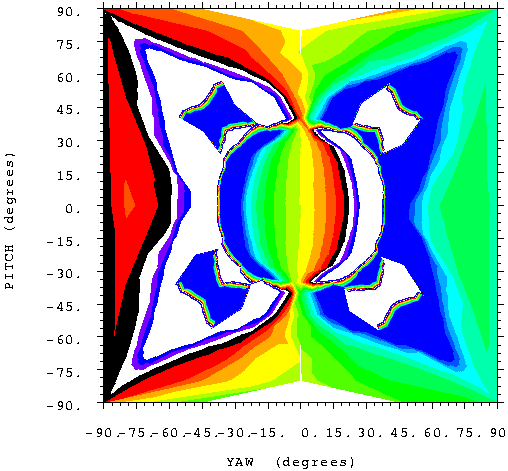Five hole pressure probes are typically used to measure 3-D flows. They can determine the yaw and pitch angles, the statgnation and static pressure in a flow.
A typical yaw coefficient for 5-hole probe is defined as
![]()
where the pressure refer to the pressure tappings on the 5-hole probe.

A truncated pyramid 5-hole probe with side-facing pressure tappings
In use, the yaw coefficient is used to determine the yaw angle. Therefore, there must be a functional relationship between the two. The figure below shows that this is not the case at flow angles in excess of 30-40 degrees.
A problem occurs with this type of probe when the yaw

Yaw coefficient vs. flow angle (zero pitch)
However, if we examine the individual hole pressure coefficients
|
|
|
|
|
|
We see that there is a unique relationship. It is only the formation of the yaw coefficient that leads to the problem. Therefore, we use an adaptation of the Least Squares method for a 5-hole Pressure Probe. To do this, we find:
![]() 4 unknowns : P0, ps, a and b
4 unknowns : P0, ps, a and b
using 5 measurements of pressure by minimising
![]()
![]()
where
![]() Pi is measured pressure for hole position i
Pi is measured pressure for hole position i
![]()
![]() is expected output for hole position i
is expected output for hole position i
In doing so, we find that the Least Squares method
![]() Extends useful range of probes to maximum
Extends useful range of probes to maximum
![]() Only limited by separation behaviour (Reynolds No.)
Only limited by separation behaviour (Reynolds No.)
See also Least Squares Method of Data Reduction: Fast Response Probes
Papers and a thesis by Roger Dambach and Howard Hodson are available in the download section. Press here to down load papers and PhD Theses.
Howard Hodson and Roger Dambach
Home | Current Research | Research Opportunities
Publications | Staff and Students
Research Facilities | Travel Information | Contact Information | Links